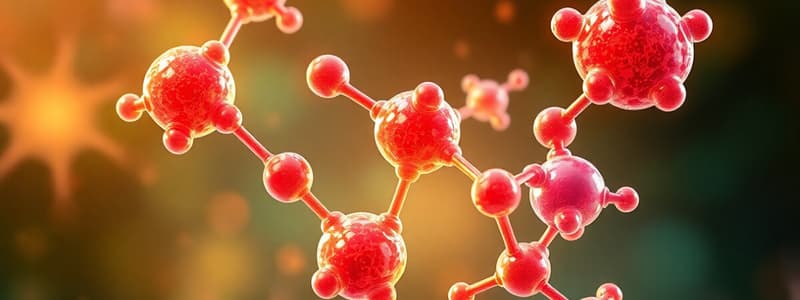Podcast
Questions and Answers
What is formed from the reaction of an aldehyde or ketone with an alcohol?
What is formed from the reaction of an aldehyde or ketone with an alcohol?
- Ethers
- Hemiacetals and Hemiketals (correct)
- Carboxylic Acids
- Alcohols
Which of the following statements is true regarding the cyclic form of glucose?
Which of the following statements is true regarding the cyclic form of glucose?
- It exclusively forms α-D-glucose.
- It cannot form stable rings due to steric hindrance.
- Cyclic hemiacetals are interconvertible in aqueous solution. (correct)
- C1 becomes a non-chiral center.
What is the significance of the carbonyl carbon in cyclic monosaccharides?
What is the significance of the carbonyl carbon in cyclic monosaccharides?
- It remains unchanged during cyclization.
- It leads to the formation of disaccharides.
- It becomes a chiral center known as the anomeric carbon. (correct)
- It prevents the formation of rings due to steric factors.
What are anomers?
What are anomers?
What mechanism facilitates the formation of cyclic hemiacetals in sugars?
What mechanism facilitates the formation of cyclic hemiacetals in sugars?
What is the primary difference between the alpha and beta forms of D-glucose?
What is the primary difference between the alpha and beta forms of D-glucose?
In a Fischer projection, how does a -OH group positioned on the right appear in a Haworth projection?
In a Fischer projection, how does a -OH group positioned on the right appear in a Haworth projection?
Which reaction converts a hexose into a uronic acid?
Which reaction converts a hexose into a uronic acid?
Which characteristic applies to aldoses with five or more carbon atoms?
Which characteristic applies to aldoses with five or more carbon atoms?
Which of the following monosaccharides is a pentose?
Which of the following monosaccharides is a pentose?
Study Notes
Reactions of Monosaccharides
- Monosaccharides with five or more carbon atoms predominantly exist in cyclic form.
- Hemiacetals and hemiketals are produced from reactions between aldehydes or ketones with alcohols.
- Inter- and intramolecular reactions can form hemiacetals or hemiketals in sugars, requiring sufficient carbon distance for stable ring formation.
Structure and Formation of Cyclic Hemiacetals
- Cyclization occurs through interactions between functional groups on distant carbons, such as C1 and C5.
- Cyclization involving C2 and C5 leads to hemiketal formation.
- The carbonyl carbon during cyclization becomes a new chiral center known as an anomeric carbon.
- D-glucose has two anomeric forms: α-D-glucose (hydroxyl groups on opposite sides) and β-D-glucose (hydroxyl groups on the same side).
- Cyclic hemiacetals in solution display mutarotation, a change in optical rotation due to the interconversion of anomers.
Anomers
- Anomers are cyclic monosaccharides that differ only at the anomeric carbon.
- The α-form has the -OH of C1 and CH2OH of C5 on opposite sides, while the β-form has them on the same side.
Fischer and Haworth Projections
- In Fischer projections, the position of hydroxyl (-OH) groups determines the Haworth projection orientation.
- If an -OH is right in Fischer, it points down in Haworth; left points up.
Characteristics of Monosaccharides
- Aldoses with five or more carbon atoms create equilibrium between alpha, beta, and open-chain forms.
- Monosaccharides may exhibit different characteristics based on their structure and functional groups.
Important Reactions of Monosaccharides
- Five key reactions include oxidation to acidic sugars, reduction to sugar alcohols, phosphate ester formation, amino sugar formation, and glycoside formation.
- These reactions are relevant to glucose and similarly structured aldoses and ketoses.
Oxidation Reactions
- The primary alcohol at C-6 of a hexose can undergo enzyme-catalyzed oxidation to form a uronic acid.
- D-glucuronic acid, derived from glucose, detoxifies phenols and alcohols in the liver and is a component of acidic polysaccharides in connective tissues.
- Weak oxidizing agents convert aldehyde groups to aldonic acids.
Reduction to Alditol
- Reduction of the carbonyl group in monosaccharides yields alditols, or sugar alcohols.
- Sorbitol, a common alditol, acts as a sweetener and moisturizing agent; it is found in various fruits and used medically for diabetics.
Reducing Sugars
- Reducing sugars can reduce silver or copper ions and include sugars with an aldehyde, hydroxyketone, or cyclic hemiacetal groups.
- Tests for reducing sugars (Benedict’s, Fehling’s, Barfoed’s) facilitate identification based on precipitation outcomes.
- The Barfoed test differentiates reducing monosaccharides from disaccharides.
Phosphate Ester Formation
- Monosaccharides can form phosphate esters by reacting hydroxyl groups with inorganic oxyacids, essential for carbohydrate metabolism.
Amino Sugar Formation
- Replacement of a monosaccharide hydroxyl group with an amino group leads to amino sugars, significant in polysaccharide structures like chitin and hyaluronic acid.
Glycoside Formation
- Glycosides form when cyclic monosaccharides react with alcohols, converting a hemiacetal to an acetal.
- Examples include glucosides from glucose and galactosides from galactose.
Glycoproteins and Blood Group Classification
- Glycoproteins consist of carbohydrate residues attached to proteins, playing critical roles in biological functions like antibody formation.
- Human blood groups (A, B, AB, O) are defined by the oligosaccharide component on glycoproteins on erythrocyte surfaces. The terminal monosaccharide determines blood group type.
Studying That Suits You
Use AI to generate personalized quizzes and flashcards to suit your learning preferences.
Related Documents
Description
This quiz focuses on the reactions of monosaccharides, particularly the formation of hemiacetals and hemiketals. Learn how these structures are formed from aldehydes or ketones reacting with alcohols, and understand their cyclic forms in carbohydrates. This is essential for mastering biochemical concepts related to sugars.



